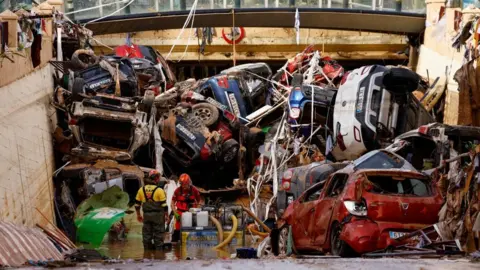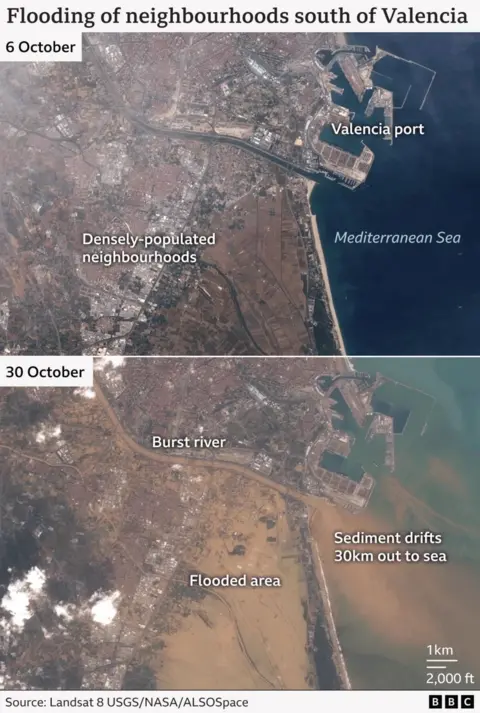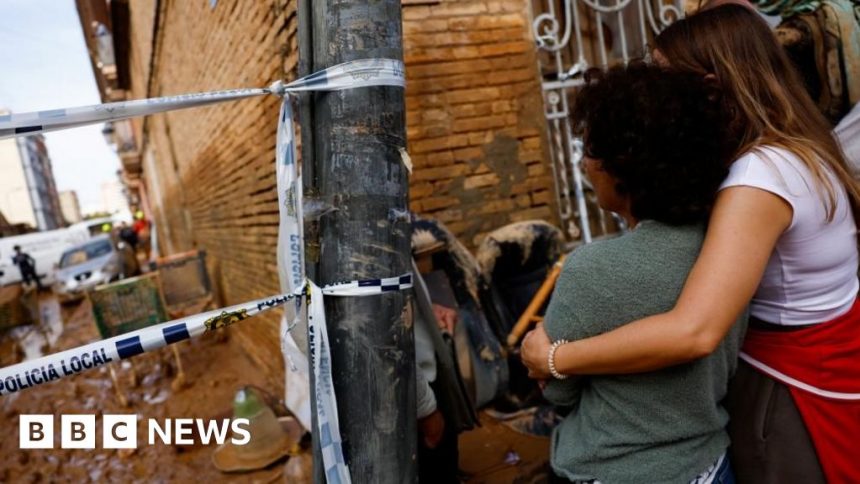Trapped in cars and garages: Why Valencia floods proved so deadly
 Reuters
ReutersAs Spain reels from the flash floods which struck the south-east of the country this week, many are wondering why the death toll, which currently stands at over 200, is so high.
Almost all of the deaths confirmed so far have been in the Valencia region on the Mediterranean coast.
Some areas have been particularly devastated: the town of Paiporta, population 25,000, reported at least 62 deaths.
Various factors, including drivers becoming trapped in their cars, poor planning by officials and extreme rainfall being exacerbated by climate change are all likely to have contributed.
The civil protection agency, overseen by the regional government, issued an emergency alert to the phones of people in and around the city of Valencia after 20:00 local time (19:00 GMT) on Tuesday, by which time the flood water was swiftly rising in many areas and in some cases already wreaking havoc.
A large number of those killed were on the roads, in many cases returning from work, when the flash floods struck.
Video footage shows how a first wave of flood water washed through Paiporta as cars were still circulating. Although rainfall was heavier in other areas, such as Utiel and Chiva, Paiporta’s geography, with a ravine running through its centre, made the impact of the flood particularly devastating.
Mayor Maribel Albalat said that the town was ill-prepared in terms of planning, with many ground-floor flats. Six residents of an elderly care home died when the flood water washed into the building when they were still on the ground floor. She also suggested there was an element of complacency.
“In Paiporta we don’t tend to have floods and people aren’t afraid,” she said.
Garages were a particular death trap.
“When it rains people normally go down to their garages to get their cars out in case their garage is flooded,” Ms Albalat said.
That appears to have been the case in the neighbourhood of La Torre, on the outskirts of Valencia, where the bodies of seven people were recovered from the garage of a residential building.
The A3 motorway connecting Valencia to Madrid was one of many roads where motorists were trapped as the water level rose, leaving them unsure whether it was safer to stay in the vehicle or not.
“There are almost certainly more people who have died because the water washed people away who had got out of their cars,” one survivor told the Telecinco TV channel. Another survivor said the water had been up to his chest.
An eye-witness described seeing one driver who had got out of his car who had strapped himself to a lamppost with his belt, to stop himself from being washed away. It is unknown whether he survived.
The mayor of Chiva, Amparo Fort, warned on Thursday that nearby there were still “hundreds of cars turned upside down and they will surely have people inside them”.
On Thursday morning, the Guardia Civil shared advice on how to escape from a car during a flood on social media. People caught in floods are advised to try and escape though their cars’ windows and windscreen.

Other factors also appear to help explain why Valencia was so devastated by the weather event.
Much of the area most heavily affected, in and surrounding the country’s third-largest city, is densely populated.
A lack of rainfall throughout the rest of the year has left the ground in many areas of eastern and southern Spain unable to absorb rainwater efficiently.
Pablo Aznar, a researcher at the Socio-Economic Observatory of Floods and Droughts (Obsis), warned that much of the area affected had undergone what he described as “untrammelled development”, with many areas covered in impermeable materials, which “increases the danger posed by these events”.
The warming climate is also likely to have contributed to the severity of the floods.
In a preliminary report, World Weather Attribution (WWA), a group of international scientists who investigate global warming’s role in extreme weather, found that the rainfall which struck Spain was 12% heavier due to climate change and that the weather event experienced is twice as likely.







